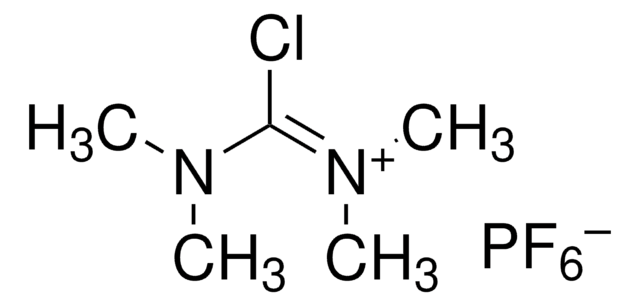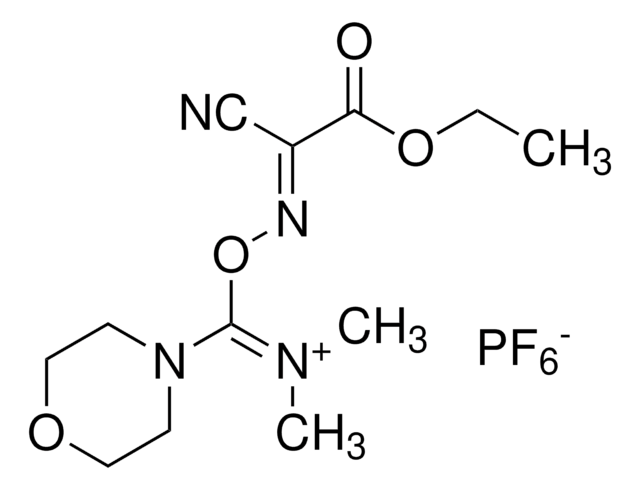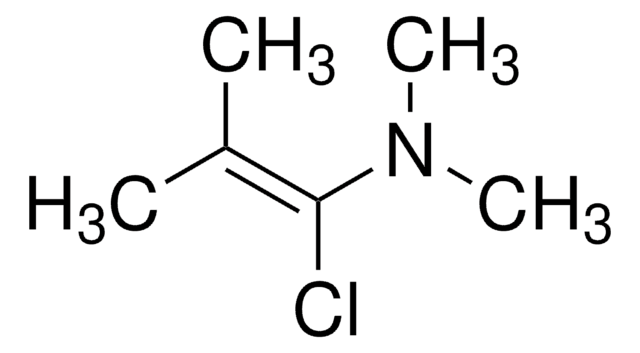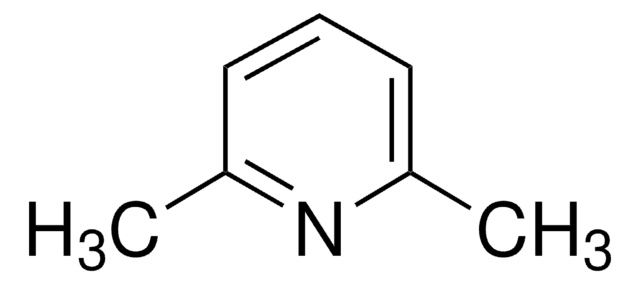모든 사진(2)
About This Item
실험식(Hill 표기법):
C6H7ClIN
CAS Number:
Molecular Weight:
255.48
Beilstein:
3572320
EC Number:
MDL number:
UNSPSC 코드:
12352100
PubChem Substance ID:
NACRES:
NA.22
추천 제품
Quality Level
분석
97%
mp
200 °C (dec.) (lit.)
작용기
chloro
SMILES string
[I-].C[n+]1ccccc1Cl
InChI
1S/C6H7ClN.HI/c1-8-5-3-2-4-6(8)7;/h2-5H,1H3;1H/q+1;/p-1
InChI key
ABFPKTQEQNICFT-UHFFFAOYSA-M
유사한 제품을 찾으십니까? 방문 제품 비교 안내
일반 설명
2-Chloro-1-methylpyridinium iodide (Mukaiyama reagent), is a commonly used reagent in organic synthesis for the activation of the hydroxy group of alcohols and carboxylic acids. It is used to synthesize derivatives of esters, lactones, amides, lactams, and ketenes from the corresponding carboxylic acids. It is also used as an efficient coupling reagent in the synthesis of peptides because of its low toxicity, simple reaction conditions, and also less expensive than EDC.
애플리케이션
2-Chloro-1-methylpyridinium iodide (CMPI) can be used as:
- A dehydrating agent for the conversion of various aldoximes to nitriles, and alcohols into alkyl thiocyanates.
- A cross-linking agent to fabricate biodegradable cross-linked hyaluronic acid film and gelatin membranes for biomedical applications.
- A condensing agent to synthesize various β-lactams from β-amino acids.
Storage Class Code
11 - Combustible Solids
WGK
WGK 3
Flash Point (°F)
Not applicable
Flash Point (°C)
Not applicable
개인 보호 장비
dust mask type N95 (US), Eyeshields, Gloves
A convenient method for the construction of β-lactam compounds from β-amino acids using 2-chloro-1-methylpyridinium iodide as condensing reagent
Huang H, et al.
Chemistry Letters (Jpn), 13(8), 1465-1466 (1984)
A novel cell support membrane for skin tissue engineering: Gelatin film cross-linked with 2-chloro-1-methylpyridinium iodide
Yeh Ming-kung, et al.
Polymer, 52(4), 996-1003 (2011)
Ming-Kung Yeh et al.
Journal of biomaterials science. Polymer edition, 23(7), 973-990 (2011-05-10)
We prepared a novel porous gelatin (GEL) sponge which was cross-linked (CL) with a zero-length crosslinker of 2-chloro-1-methylpyridinium iodide (CMPI), and compared CPMI with 1-ethyl-3,3-dimethylaminoproplycarbodiimide (EDC). The ninhydrin assay indicated that the CMPI-CL-GEL sponge had a higher degree of cross-linking
Dmitrii V Belykh et al.
Molecules (Basel, Switzerland), 23(7) (2018-07-18)
This article focuses on the antiradical activity of a number of 2,6-diisobornylphenol-porphyrin conjugates with various spacers between the porphyrin and phenolic fragments in the model reaction of ethylbenzene oxidation initiated by azoisobutyric acid dinitrile. The study has shown that the
Jenn-Jong Young et al.
Journal of biomaterials science. Polymer edition, 15(6), 767-780 (2004-07-17)
In order to obtain much slower biodegradable films, which are often required for biomedical applications, we have developed a series of studies on heterogeneous cross-linking of hyaluronic acid (HA) films by using 2-chloro-1-methylpyridinium iodide (CMPI) or 1-ethyl-(3,3-dimethylaminopropyl)carbodiimide (EDC) as cross-linking
자사의 과학자팀은 생명 과학, 재료 과학, 화학 합성, 크로마토그래피, 분석 및 기타 많은 영역을 포함한 모든 과학 분야에 경험이 있습니다..
고객지원팀으로 연락바랍니다.








